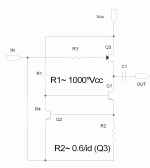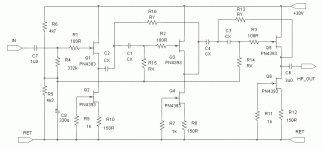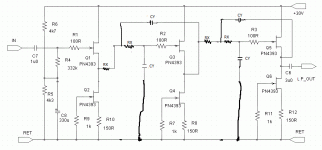EUVL -
The pentodish characteristic of the BSS159 mosfet is perfect for a current source, regardless of the IDSS. For a unity gain active filter app for line-level signals, it's a no-brainer. The PN4393, being a short-channel device originally
intended as a chopper fet makes a nice amplifier if pressed into that service, but a so-so current source.
When I bought my BSS159s from Digi-Key, there was one flavor available. What you got was one fairly narrow range of IDSS, but you didn't get to select which one. The parts I bought at the time are pretty consistent in terms of IDSS vs source resistor. It looks like they're opening up their options now - maybe it pumps up the overall device yield, which is what all the semiconductor vendors care about behind the scenes first and foremost.
The pentodish characteristic of the BSS159 mosfet is perfect for a current source, regardless of the IDSS. For a unity gain active filter app for line-level signals, it's a no-brainer. The PN4393, being a short-channel device originally
intended as a chopper fet makes a nice amplifier if pressed into that service, but a so-so current source.
When I bought my BSS159s from Digi-Key, there was one flavor available. What you got was one fairly narrow range of IDSS, but you didn't get to select which one. The parts I bought at the time are pretty consistent in terms of IDSS vs source resistor. It looks like they're opening up their options now - maybe it pumps up the overall device yield, which is what all the semiconductor vendors care about behind the scenes first and foremost.
The 6906 option (pre-selection) has been around for years (>2).
I always buy the 6906 when they are available.
The same penthode characteristic can be had if you take a 2SK369V and degenerate to less then 5mA or so (Vgs = -0.3V, Rdegen 60R).
If you need more current you can then have multiple in parallel.
Much lower noise then BSS159.
But I understand you like to use other parts.
Everyone has his favour.
Patrick
I always buy the 6906 when they are available.
The same penthode characteristic can be had if you take a 2SK369V and degenerate to less then 5mA or so (Vgs = -0.3V, Rdegen 60R).
If you need more current you can then have multiple in parallel.
Much lower noise then BSS159.
But I understand you like to use other parts.
Everyone has his favour.
Patrick
Last edited:
I'll save my 2SK170s (since I don't have any 369s) for apps where the low noise characteristics are really really needed, especially as they are somewhat hard to come by. For something with high input signal ( a line output) and nominally unity gain the noise specs are far less critical.
You can get 2SK209BL from Mouser.
Only USD 0.18 each for 1k quantity, or USD 0.15 for a reel (3k).
Not much more expensive than PN4393.
And a reel should be enough for life time stock.
Degenerate to Vgs -0.3V will also give you a very good 5mA ccs.
The more degeneration you use, the better the penthode.
AND you can use it also as the follower.
No need to use different devices, and the same device tracks much better thermally.
If you just want a JFET follower, then use 2SK2145.
Just reverse D & S for one JFET and you have it all done for you in one SOT23-5.
Reasonably well matched (though no spec.), and perfect thermal tracking.
Don't take my word. Buy a few from Mouser to try them out.
Patrick
Only USD 0.18 each for 1k quantity, or USD 0.15 for a reel (3k).
Not much more expensive than PN4393.
And a reel should be enough for life time stock.
Degenerate to Vgs -0.3V will also give you a very good 5mA ccs.
The more degeneration you use, the better the penthode.
AND you can use it also as the follower.
No need to use different devices, and the same device tracks much better thermally.
If you just want a JFET follower, then use 2SK2145.
Just reverse D & S for one JFET and you have it all done for you in one SOT23-5.
Reasonably well matched (though no spec.), and perfect thermal tracking.
Don't take my word. Buy a few from Mouser to try them out.
Patrick
Patrick could I use these?
Compre Transistores JFET Transistor JFET, 2SK209-Y(TE85L,F), N-Canal, 14 mA, 10 V, SMini, 3-Pines Toshiba 2SK209-Y(TE85L,F) en RS Online y lo recibir en 24 horas.
Do you have adaptors for through-hole?
TIA
Felipe
Compre Transistores JFET Transistor JFET, 2SK209-Y(TE85L,F), N-Canal, 14 mA, 10 V, SMini, 3-Pines Toshiba 2SK209-Y(TE85L,F) en RS Online y lo recibir en 24 horas.
Do you have adaptors for through-hole?
TIA
Felipe
@wrenchone
My friend dai (diyaudio member) have enough stock 4393 for the followers but not for the current sources however he has some 2n5433 & 2n5434 these are long channel devices that are more suitable for current sources than the 4393 could I using a current of 5 to 10 mill amps?
My friend dai (diyaudio member) have enough stock 4393 for the followers but not for the current sources however he has some 2n5433 & 2n5434 these are long channel devices that are more suitable for current sources than the 4393 could I using a current of 5 to 10 mill amps?
If people are opting for surface mount components, the sensible option is to try and avoid matching if possible 'cause its expensive/a pain. Recall I posted a set of mix n' match elements in posts 32 and 35. These can be cobbled together to realize a unity gain cell/follower with the components you have on hand.
The circuit shown in the attachment uses current source "B' from post 32 of this thread, which is pretty non-critical as to the bipolar transistors you use, as long as they're NPN. I'm sure I'll get pundits yammering away that you can't get decent results without yada yada yada, but it really doesn't matter that much for this application, a dirt-stupid follower for a line-level input. What do you have? If you have a cheap VOM, these days it most likely has a function that can read the HFE of an NPN or PNP bipolar transistor, and you can select for max gain from the devices you have, if you think it matters.
The device on top of the current sink is depicted as an N-jfet, but it could be a mosfet (N-channel, enhancement or depletion mode) an N-channel jfet, or even an NPN bipolar. It's a relatively non-critical circuit with a pretty wide window for success.
The circuit shown in the attachment uses current source "B' from post 32 of this thread, which is pretty non-critical as to the bipolar transistors you use, as long as they're NPN. I'm sure I'll get pundits yammering away that you can't get decent results without yada yada yada, but it really doesn't matter that much for this application, a dirt-stupid follower for a line-level input. What do you have? If you have a cheap VOM, these days it most likely has a function that can read the HFE of an NPN or PNP bipolar transistor, and you can select for max gain from the devices you have, if you think it matters.
The device on top of the current sink is depicted as an N-jfet, but it could be a mosfet (N-channel, enhancement or depletion mode) an N-channel jfet, or even an NPN bipolar. It's a relatively non-critical circuit with a pretty wide window for success.
Attachments
R10 and Q2 determine the current through the first Follower.
measure each follower pair and add them up to determine the total quiescent current demand.
Allow for current through bias string, R6+R5. I increased these to 9k1 and 10k to reduce current demand.
The absolute maximum current demand is Iq +-Iq for a symetrical waveform.
But in practice the more likely maximum demand is ~1.2*Iq to 1.5*Iq.
measure each follower pair and add them up to determine the total quiescent current demand.
Allow for current through bias string, R6+R5. I increased these to 9k1 and 10k to reduce current demand.
The absolute maximum current demand is Iq +-Iq for a symetrical waveform.
But in practice the more likely maximum demand is ~1.2*Iq to 1.5*Iq.
If the gm and the Idss are very similar, then the 220r source resistor will reduce the Id to a very similar level.
You get that by selecting the same type, that gets the gm to a similar level.
Then you select by Idss. That gets you to a slope region on the gm curve.
Then check/measure what Id you get for that device with 220r for Rs.
That Id is your Iq.
Power dissipation (Pq) is Iq*Vds and should be <<Pmax. I aim for Pq<25% of Pmax
I can't measure the Ipk during music signals.
That's why I use that estimate of 1.2* to 1.5*
Your PSU MUST be able to supply the peak demand of the amplifier. Most of this peak demand comes from the last few capacitors.
You get that by selecting the same type, that gets the gm to a similar level.
Then you select by Idss. That gets you to a slope region on the gm curve.
Then check/measure what Id you get for that device with 220r for Rs.
That Id is your Iq.
Power dissipation (Pq) is Iq*Vds and should be <<Pmax. I aim for Pq<25% of Pmax
I can't measure the Ipk during music signals.
That's why I use that estimate of 1.2* to 1.5*
Your PSU MUST be able to supply the peak demand of the amplifier. Most of this peak demand comes from the last few capacitors.
Last edited:
- Status
- This old topic is closed. If you want to reopen this topic, contact a moderator using the "Report Post" button.
- Home
- Source & Line
- Analog Line Level
- JFET Active Crossover

![WP_20141213_003[1].jpg](/community/data/attachments/412/412745-a1eb03e384110973c43226417a17765e.jpg)

